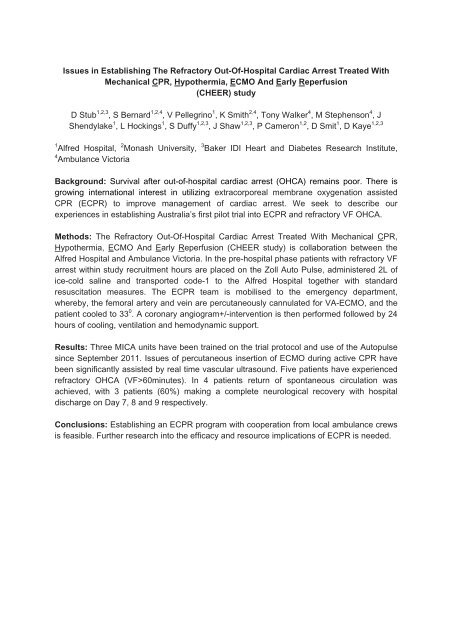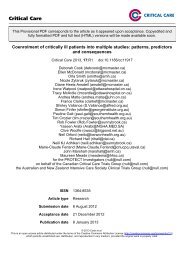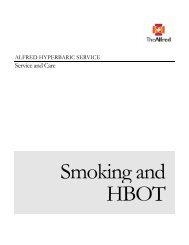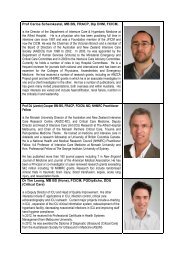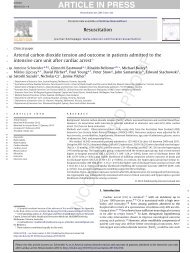Media Report
Media Portal Report - Alfred Intensive Care Unit
Media Portal Report - Alfred Intensive Care Unit
- No tags were found...
You also want an ePaper? Increase the reach of your titles
YUMPU automatically turns print PDFs into web optimized ePapers that Google loves.
Issues in Establishing The Refractory Out-Of-Hospital Cardiac Arrest Treated With<br />
Mechanical CPR, Hypothermia, ECMO And Early Reperfusion<br />
(CHEER) study<br />
D Stub 1,2,3 , S Bernard 1,2,4 , V Pellegrino 1 , K Smith 2,4 , Tony Walker 4 , M Stephenson 4 , J<br />
Shendylake 1 , L Hockings 1 , S Duffy 1,2,3 , J Shaw 1,2,3 , P Cameron 1,2 , D Smit 1 , D Kaye 1,2,3<br />
1 Alfred Hospital, 2 Monash University, 3 Baker IDI Heart and Diabetes Research Institute,<br />
4 Ambulance Victoria<br />
Background: Survival after out-of-hospital cardiac arrest (OHCA) remains poor. There is<br />
growing international interest in utilizing extracorporeal membrane oxygenation assisted<br />
CPR (ECPR) to improve management of cardiac arrest. We seek to describe our<br />
experiences in establishing Australia’s first pilot trial into ECPR and refractory VF OHCA.<br />
Methods: The Refractory Out-Of-Hospital Cardiac Arrest Treated With Mechanical CPR,<br />
Hypothermia, ECMO And Early Reperfusion (CHEER study) is collaboration between the<br />
Alfred Hospital and Ambulance Victoria. In the pre-hospital phase patients with refractory VF<br />
arrest within study recruitment hours are placed on the Zoll Auto Pulse, administered 2L of<br />
ice-cold saline and transported code-1 to the Alfred Hospital together with standard<br />
resuscitation measures. The ECPR team is mobilised to the emergency department,<br />
whereby, the femoral artery and vein are percutaneously cannulated for VA-ECMO, and the<br />
patient cooled to 33 0 . A coronary angiogram+/-intervention is then performed followed by 24<br />
hours of cooling, ventilation and hemodynamic support.<br />
Results: Three MICA units have been trained on the trial protocol and use of the Autopulse<br />
since September 2011. Issues of percutaneous insertion of ECMO during active CPR have<br />
been significantly assisted by real time vascular ultrasound. Five patients have experienced<br />
refractory OHCA (VF>60minutes). In 4 patients return of spontaneous circulation was<br />
achieved, with 3 patients (60%) making a complete neurological recovery with hospital<br />
discharge on Day 7, 8 and 9 respectively.<br />
Conclusions: Establishing an ECPR program with cooperation from local ambulance crews<br />
is feasible. Further research into the efficacy and resource implications of ECPR is needed.


